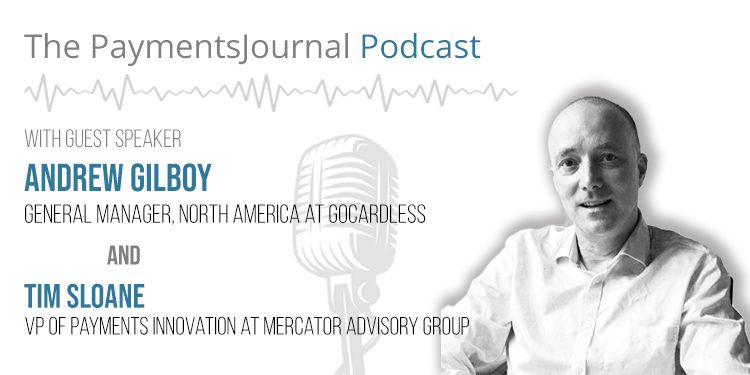It’s undeniable: open banking is coming to the United States. Ultimately, its arrival will revolutionize both consumer and business finance and improve the Software as a Service (SaaS) customer lifecycle from start to finish.
To learn more about how and why SaaS businesses should channel the power of open banking, PaymentsJournal sat down with Andrew Gilboy, General Manager, North America at GoCardless, and Tim Sloane, VP of Payments Innovation at Mercator Advisory Group.
What is open banking?
Understanding the importance of leveraging open banking starts with knowing what open banking is. According to Gilboy, “open banking allows customers to actually give their permission to an application or company to look at their financial information and payment transactions.” This enables that company or application to take payments directly from a customer’s bank account.
Customers are willing to grant this permission because doing so is beneficial to them. When companies or applications can see their financial information, they can simplify tasks from identity verification to assessing a consumer’s creditworthiness for a loan.
One of the most basic capabilities of open banking is the ability of the company or application to see account balances. “They actually know what impact that transaction is going to have on their balance, and it would be possible for the third party or the bank to then offer credit or let [the consumer] select the account or even select another bank. With open banking, that’s all possible. With existing rails, it is not,” said Sloane.
Using open banking, companies can take payments directly from their customers’ bank accounts in real time and without the middlemen, saving them considerable cost and churn. This is particularly true for business models that rely on recurring payments, which tend to have high levels of churn.
The global open banking landscape
It is also important to understand that the global rollout of open banking has been inconsistent. Regulators, rather than the financial services industry, were at the heart of open banking in Europe. This began when the EU rolled out an open banking regulation called PSD2 that defined several functions that banks must make available to registered service providers. These functions include the need for banks to have application programming interfaces (APIs) that can be used to make payments and access accounts to look at customer data.
“The EU vision is that this is going to enable a pay-by-bank capability that targets both retail and commercial users,” said Sloane. But this top-to-bottom approach has had a rocky start, as individual countries within the EU have followed their own roadmaps and PSD2 failed to clearly define API standards.
Meanwhile, the United States is taking a bottom-to-top approach. “It’s every bank looking at what benefits them relative to opening up their APIs and executing their plan,” added Sloane. “But none of this is directed to consumer payments for merchants, which is an open need and exactly what was targeted in the EU, and we haven’t seen that yet in the U.S.”
There is still reason to be optimistic about the U.S. catching up to Europe, as a majority of global merchants that would benefit greatly from open banking are based in the United States. As these merchants recognize this value, they may drive the open banking market nationally.
Open banking improves the SaaS customer lifecycle
Broadly speaking, companies running on a recurring subscription business model will benefit the most from the implementation of open banking capabilities. Open banking lowers churn, costs, and fraud related to recurring payments while reducing receivables. For example, GoCardless has already integrated with over 250 billing platforms to add functionality to their payment flow and make recurring payments possible. When the company DocuSign integrated with open banking, its total conversion rate increased by 11%.
“In terms of use cases, there are new [open banking] use cases that are a massive improvement both in the B2B world and in the B2C world. We’re not going to replace [other payment options], it’s just going to be another option,” explained Gilboy.
That said, recurring models are not the only beneficiaries of open banking. In fact, open banking improves the SaaS customer lifecycle from onboarding and signup through the completion of a transaction by offering additional insights and personalization opportunities. For example, a company might see that a consumer has insufficient funds to complete a payment and suggest they use another account to do so. If the customer hadn’t granted access to their account balance, the company would be unable to make that suggestion.
Challenges exist, but the future is bright
Despite the promising nature of open banking, there are some obstacles preventing it from further saturation in the U.S. market. One obstacle is the fact that checks are still widely used—over 40% of B2B transactions are still paid with checks.
Consumer preferences also stand in the way. In the U.S. specifically, consumers have a heavy preference toward credit cards. Until they see a reason to change their ways, that dominance is unlikely to be threatened by open banking.
That said, open banking will become more popular over time. As younger consumers and global merchants become accustomed to and recognize the benefits of open banking options, adoption will grow. Eventually, open banking could threaten credit cards’ dominance as the preferred payment method. “Banks have got to come up to speed and be able to manage this, because it’s coming like a freight train,” said Sloane.
So, while it’s impossible to predict exactly what’s to come, the future for open banking is bright. “I can see in five years’ time it being a common alternative. You’ll have your credit card, you’ll have your paper, and you’ll have your open banking, and you’ll make the choice,” concluded Gilboy.
